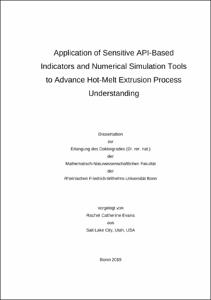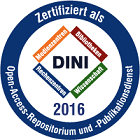Application of Sensitive API-Based Indicators and Numerical Simulation Tools to Advance Hot-Melt Extrusion Process Understanding

Application of Sensitive API-Based Indicators and Numerical Simulation Tools to Advance Hot-Melt Extrusion Process Understanding

| dc.contributor.advisor | Wagner, Karl Gerhard | |
| dc.contributor.author | Evans, Rachel Catherine | |
| dc.date.accessioned | 2020-04-26T22:47:14Z | |
| dc.date.available | 2020-04-26T22:47:14Z | |
| dc.date.issued | 11.09.2019 | |
| dc.identifier.uri | https://hdl.handle.net/20.500.11811/8069 | |
| dc.description.abstract | This dissertation explored the use of active pharmaceutical ingredients (APIs) as indicator substances as well as numerical process simulation to enhance process understanding of hot-melt extrusion (HME) in the pharmaceutical field. Two APIs, torasemide and telmisartan, were identified which, when combined with the appropriate matrix and processed at appropriate conditions, behaved like highly sensitive indicator substances. With these indicator substances, two relevant critical quality attributes (CQAs) for the HME process, degradation and residual crystallinity, enabled analysis of process performance, evaluation of scaling and were correlated with both empirical and simulated process performance. Customized formulations were developed for both APIs in order to target the relevant process and CQA design spaces. Formulations were developed to minimize the impact of the API dissolution into the polymeric matrix on melt viscosity or thermal properties by minimizing the difference between the Tg of the API and that of the matrix. Both APIs were processed below their single-component melting points as well as below their solubility temperatures in the matrix system. By doing so, the APIs were forced to dissolve into the surrounding matrix rather than first melt and then disperse and distribute. As a result, for the given drug loading, dissolution was never complete and residually crystalline API material was always present after extrusion. In the case of torasemide, the amount of residually crystalline API material present was correlated to both melt temperature and residence time. For the telmisartan formulations, it was highly correlated with melt temperature. Due to a dissolve-then-degrade mechanism, torasemide degradation was dependent on the amount of API dissolved in the Soluplus®-PEG 1500 matrix. Numerical simulation with the commercially available software Ludovic® enabled correlation of the CQAs with simulation-derived results. For torasemide, the empirical relationship between the sum of degradants and the residual crystallinity was found to correlate with the simulated integral of the time that the material spent above the dissolution temperature of torasemide in the polymeric matrix. For telmisartan, in the samples which exhibited almost no residual crystallinity, the simulated maximum melt temperature was equivalent to the solubility temperature of the API in the copovidone-based matrix, irrespective of processing conditions or the plasticizing polysorbate 80 content. The telmisartan system and process simulation were further used to study scaling of the HME process. Simulation was utilized to select the most processable formulation as well as to identify processing conditions which would yield a scaled quasi-adiabatic process while residual crystallinity was used to assess the success of scaling. | en |
| dc.language.iso | eng | |
| dc.rights | In Copyright | |
| dc.rights.uri | http://rightsstatements.org/vocab/InC/1.0/ | |
| dc.subject | Schmelzextrusion | |
| dc.subject | Simulation | |
| dc.subject | Torasemid | |
| dc.subject | Telmisartan | |
| dc.subject | Pharmazeutische Technologie | |
| dc.subject | hot-melt extrusion | |
| dc.subject | torasemide | |
| dc.subject | pharmaceutical technology | |
| dc.subject | amorphous solid dispersion | |
| dc.subject.ddc | 500 Naturwissenschaften | |
| dc.title | Application of Sensitive API-Based Indicators and Numerical Simulation Tools to Advance Hot-Melt Extrusion Process Understanding | |
| dc.type | Dissertation oder Habilitation | |
| dc.publisher.name | Universitäts- und Landesbibliothek Bonn | |
| dc.publisher.location | Bonn | |
| dc.rights.accessRights | openAccess | |
| dc.identifier.urn | https://nbn-resolving.org/urn:nbn:de:hbz:5n-55636 | |
| ulbbn.pubtype | Erstveröffentlichung | |
| ulbbnediss.affiliation.name | Rheinische Friedrich-Wilhelms-Universität Bonn | |
| ulbbnediss.affiliation.location | Bonn | |
| ulbbnediss.thesis.level | Dissertation | |
| ulbbnediss.dissID | 5563 | |
| ulbbnediss.date.accepted | 17.07.2019 | |
| ulbbnediss.institute | Mathematisch-Naturwissenschaftliche Fakultät : Fachgruppe Pharmazie / Pharmazeutisches Institut/Pharmazeutische Technologie | |
| ulbbnediss.fakultaet | Mathematisch-Naturwissenschaftliche Fakultät | |
| dc.contributor.coReferee | Lamprecht, Alf |
Dateien zu dieser Ressource
Das Dokument erscheint in:
-
E-Dissertationen (4339)




